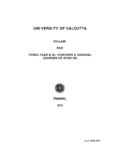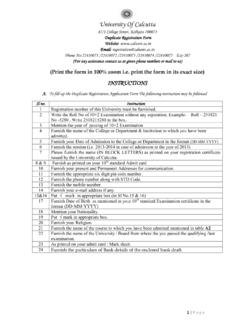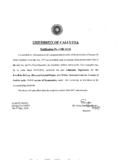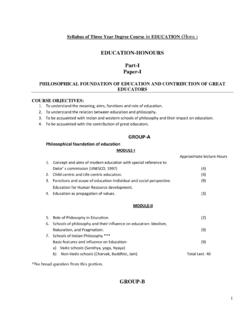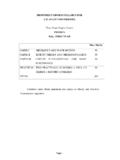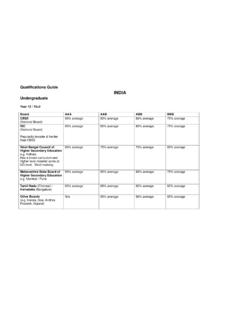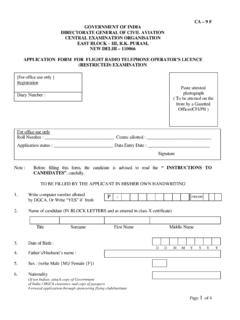Transcription of Syllabus for Physics - University of Calcutta
1 1 University OF Calcutta SYLLABI F O R THREE-YEAR HONOURS AND GENERAL DEGREE COURSES OF STUDIES Physics 2010 2 2010-2011 Honours Part I 1st year : Paper I (100 Marks) Unit-01: 50 Marks- Mathematical Methods I & Mathematical Methods II Unit-02: 50 Marks- Waves and Optics I & Electronics I Paper IIA (50 Marks) Unit-03: 50 Marks- Classical & Thermal Physics I Paper IIB (50 Marks) Unit-04: 50 Marks- Laboratory Part II 2nd year : Paper III (100 Marks) Unit-05: 50 Marks- Electronics II & Electricity and Magnetism Unit-06: 50 Marks- Electrostatics & Waves and Optics II Paper IVA (50 Marks) Unit-07: 50 Marks- Quantum & Thermal Physics II Paper IVB (50 Marks) Unit-08: 50 Marks- Laboratory Part III 3rd year : Paper V (100 Marks) Unit-09: 50 Marks- Classical Mechanics II & Special Theory of Relativity Unit-10: 50 Marks- Quantum & Atomic Physics Paper VI (100 Marks) Unit- 11: 50 Marks- Nuclear and Particle Physics I & Nuclear and Particle Physics II Unit- 12: 50 Marks- Solid State Physics I & Solid State Physics II Paper VIIA (50 Marks) Unit- 13: 50 Marks- Statistical Mechanics & Electromagnetic Theory Paper VIIB (50 Marks) Unit- 14: 50 Marks- Laboratory Paper VIIIA (50 Marks) Unit- 15.
2 50 Marks- Laboratory Paper VIIIB (50 Marks) Unit- 16: 50 Marks- Computer laboratory Paper I Unit - I MATHEMATICAL METHODS I (25 Marks) LECTURES: 25 + 5 Tutorial 1. Preliminary Topics Infinite sequences and series - convergence and divergence, conditional and absolute convergence, ratio test for convergence. Functions of several real variables - partial differentiation, Taylor's series, multiple integrals. Random variables and probabilities - statistical expectation value, variance; Analysis of random errors: Probability distribution functions (Binomial, Gaussian, and Poisson) (10) 32. Ve c t o r A n a l y s i s Transformation properties of vectors; Differentiation and integration of vectors; Line integral, volume integral and surface integral involving vector fields; Gradient, divergence and curl of a vector field; Gauss' divergence theorem, Stokes' theorem, Green's theorem - application to simple problems; Orthogonal curvilinear co-ordinate systems, unit vectors in such systems, illustration by plane, spherical and cylindrical co-ordinate systems only.
3 (10) 3. Matrices Hermitian adjoint and inverse of a matrix; Hermitian, orthogonal, and unitary matrices; Eigenvalue and eigenvector (for both degenerate and non-degenerate cases); Similarity transformation; diagonalisation of real symmetric matrices. (5) MATHEMATICAL METHODS II (25 Marks) LECTURES 25 + 5 Tutorial Differential Equations Solution of second order linear differential equations with constant coefficients and variable coefficients by Frobenius method (singularity analysis not required); Solution of Legendre and Hermite equations about x=0; Legendre and Hermite polynomials - orthonormality properties. (7) 2. Partial Differential Equations Solution by the method of separation of variables; Laplace's equation and its solution in Cartesian, spherical polar (axially symmetric problems), and cylindrical polar (`infinite cylinder' problems) coordinate systems.
4 (11) 3. Fourier Series Fourier expansion statement of Dirichlet s condition, analysis of simple waveforms with Fourier series. Introduction to Fourier transforms; the Dirac-delta function and its Fourier transform; other simple examples. Vibration of stretched strings- plucked and struck cases. (7) Paper I Unit-II WAVES & OPTICS I (25 Marks) LECTURES 25 + 5 Tutorial 1. Linear Harmonic Oscillator LHO. Free and forced vibrations. Damping. Resonance. Sharpness of resonance. Acoustic, optical, and electrical resonances: LCR circuit as an example of the resonance condition. A pair of linearly coupled harmonic oscillators --- eigenfrequencies and normal modes. (7) 2.
5 Waves Plane progressive wave in 1-d and 3-d. Plane wave and spherical wave solutions. Dispersion: phase velocity and group velocity. (5) 3. Fermat's principle Fermat's principle and its application on plane and curved surfaces. (3) 44. Cardinal points of an optical system Two thin lenses separated by a distance, equivalent lens, different types of magnification : Helmholtz and Lagrange's equations, paraxial approximation, introduction to matrix methods in paraxial optics simple application. (5) 5. Wave theory of light Huygen s principle; deduction of law of reflection and refraction. (5) ELECTRONICS I (25 Marks) LECTURES 25 + 5 Tutorial 1.
6 Network Thevenin Theorem, Norton theorem, Maximum power transfer theorem, Superposition principle, T and networks. (3) 2. Semiconductor diodes: p-n junction diode, I-V characteristics, Zener diode and its applications, optoelectronic diodes: LED, photo diodes. (2) 3. Bipolar junction transistors (BJT) pnp and npn structures; active and saturation regions, characteristics of BJT, common emitter configuration, input and output characteristics, and of a transistor and their interrelation, common base configuration, output characteristics. Two port analysis of a transistor, definition of h-parameters, loadline concept, emitter follower, biasing methods, stability factor, low frequency model. Comparison of CB, CC and CE amplifiers. (6) 4.
7 Field effect transistors (FET) Classification of various types of FETs, construction of junction FET, drain characteristics, biasing, operating region, pinch-off voltage. MOSFET: construction of enhancement and depletion type, principle of operation and characteristics. Elementary ideas of CMOS and NMOS. (7) 5. Digital electronics Boolean theorem, Boolean identities, OR, AND, NOT, NAND, NOR gates, Ex-OR, Ex-NOR gates, universal gate, de-Morgan s theorem, 1 s and 2 s complement, binary number addition, subtraction and multiplication, functional completeness, S-O-P and P-O-S representation, Karnaugh map. (7) Paper IIA Unit-I CLASSICAL MECHANICS I (25 Marks) LECTURES: 25 + 5 Tutorial 1. Mechanics of a Single Particle Velocity and acceleration of a particle in (i) plane polar coordinates - radial and cross-radial components (ii) spherical polar and (iii) cylindrical polar co-ordinate system; Time and path integral of force; work and energy; Conservative force and concept of potential; Dissipative forces; Conservation of linear and angular momentum.
8 (7) 52. Mechanics of a System of Particles Linear momentum, angular momentum and energy - centre of mass decompositon; Equations of motion, conservation of linear and angular momenta. (6) 3. Rotational Motion Moment of inertia, radius of gyration; Energy and angular momentum of rotating systems of particles; Parallel and perpendicular axes theorems of moment of inertia; Calculation of moment of inertia for simple symmetric systems; Ellipsoid of inertia and inertia tensor; Setting up of principal axes in simple symmetric cases. Rotating frames of reference - Coriolis and centrifugal forces, simple examples.
9 Force-free motion of rigid bodies - free spherical top and free symmetric top. (12) THERMAL Physics I (25 Marks) LECTURES 25 + 5 Tutorial Theory of Gases Basic assumptions of kinetic theory, Ideal gas approximation, deduction of perfect gas laws. Maxwell s distribution law (both in terms of velocity and energy), root mean square and most probable speeds. Finite size of molecules : Collision probability, Distribution of free paths and mean free path from Maxwell s distribution. Degrees of freedom, equipartition of energy (detailed derivation not required). (8) Phenomena Viscosity, thermal conduction and diffusion in gases. Brownian Motion: Einstein s theory, Perrin s work, determination of Avogardo number.
10 (4) Gases Nature of intermolecular interaction : isotherms of real gases. van der-Waals equation of state, Other equations of state (mention only), critical constants of a gas, law of corresponding states; Virial Coefficients, Boyle temperature. (4) of Heat Thermal conductivity, diffusivity. Fourier s equation for heat conduction its solution for rectilinear and radial (spherical and cylindrical) flow of heat. (3) Radiation : Spectral emissive and absorptive powers, Kirchoff s law, blackbody radiation, energy density, radiation pressure. Stefan-Boltzmann law, Newton's law of cooling, Planck s law (no detailed derivation). (6) 6 Paper III Unit-I ELECTRONICS II (25 Marks) LECTURES 25 + 5 Tutorial 1.

